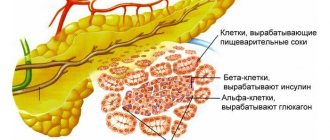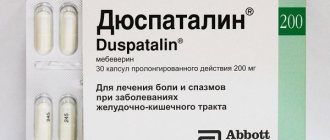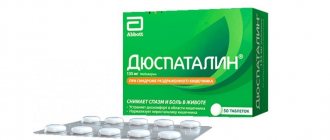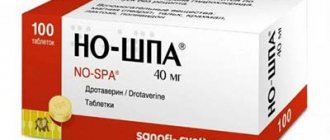About the medicine
The active ingredient of this drug is mebeverine. It modifies the functioning of ion channels in smooth muscle and prevents contraction of muscle fibers. It acts primarily on the organs of the digestive system, but does not reduce intestinal motility.
Duspatalin relieves only pathologically increased motility, without reducing normal one, and does not cause one of the common complications when using antispasmodic therapy - intestinal atony.
Available in tablets and capsules. The latter contain a larger amount of active substance.
Capsules have the effect of prolonged release of the active substance. The drug is excreted from the body with bile and urine; even with long-term use, it does not have significant accumulation properties.
Duspatalin for pancreatitis is used to eliminate painful symptoms and relieve spasms. The drug acts quickly, the effect lasts for 8 hours. Produced by several companies from different countries - USA, France, Germany, the Netherlands. The antispasmodic has a direct effect on the smooth muscles of the gastrointestinal tract without disrupting natural intestinal motility. Painful symptoms are eliminated by relaxing muscles. Used for symptomatic treatment of diseases of the digestive system.
Prescribing Duspatalin for pancreatic pathologies will help:
- eliminate pain in the gland;
- restore microcirculation in the damaged organ;
- restore the quality of tissue in the gland;
- restores cellular balance;
- improves communication between the pancreas and the duodenum by dilating the ducts;
- It will increase blood circulation, which will reduce pain.
It is necessary to prescribe Duspatalin for pancreatitis if the symptom of pain is severe. The drug helps to liquefy pancreatic secretions, stagnation of which can lead to stone formation. Prevents the death of gland tissue.
The antispasmodic has an effect on the smooth muscles of the gastrointestinal tract, eliminating spasm. Does not interfere with intestinal motility. The therapeutic effect occurs within 15 minutes and lasts up to 8 hours. This feature of the drug allows you to take it only twice a day. Duspatalin is used for symptomatic treatment in combination with other medications. Combines with antacids, prokinetics, probiotics, proton pump inhibitors, sorbents.
The maximum concentration of the active substance is observed after 3 hours. The long-lasting effect is maintained due to slow metabolism. Duspatalin is eliminated gradually over 8 hours. The drug eliminates spasms, normalizes blood circulation, and relieves pain and bloating.
The drug is produced in the form of tablets or capsules with a prolonged action. The active substance is encased in a gelatin capsule, which protects the drug from premature destruction in the stomach. The membrane dissolves in the intestine, is absorbed by the tissues, but does not enter the systemic bloodstream. Packaged in packages with different numbers of capsules.
Duspatalin for pancreatitis: should I take it?
Is it possible to take Duspatalin for pancreatitis, patients ask. Doctors are unanimous in their opinion - yes, since this drug prevents obstruction of the pancreatic duct and is able to eliminate spasm without disturbing the natural tone of the intestine. Duspatalin (also known as mebeverine hydrochloride) is a representative of the group of antispasmodics.
It is important to understand the mechanism of pain syndromes in pancreatitis in order to understand the principle of action of the drug. The cause of pain is most often irritation of the nerve endings, which occurs due to a decrease in the lumen of the pancreatic duct. This, in turn, is possible due to a violation of the outflow of secretion. Also, with pancreatic disease, there is a high probability of the formation of stones in the pancreas. Removal of stones in most cases occurs surgically. Due to digestive dysfunction caused by enzyme deficiency, there is irritation of the intestines by food bolus. As a result, the patient experiences dyspeptic disorders, diarrhea, loose stools, spasms and pain, which can radiate to the hypochondrium, lower back, abdomen, be burning, sharp, boring, etc.
Indications for the use of Duspatalin for pancreatitis are:
- Spasm of the gastrointestinal tract;
- Intestinal and/or biliary colic;
- Sphincter of Oddi dysfunction;
- Irritable bowel syndrome;
- Constipation, etc.
What is better to take - tablets or capsules?
How to take Duspatalin for pancreatitis and what form of release to choose? These are questions related to the topic of “self-medication,” since inflammation of the pancreas (pancreas) is a serious pathology, and prescribing medications is the prerogative of a doctor.
However, this product is sold without a prescription, and its packaging includes instructions that clearly describe which forms (tablets, capsules) are most effective if pancreatitis is diagnosed. The drug has several dosage forms that are convenient for use - long capsules and coated tablets.
Tablet Duspatalin is recommended to be taken as follows:
- shortly before meals, 20-30 minutes;
- The tablet is taken whole and should not be chewed;
- the medicine needs to be “helped” to be absorbed, and for this you need to wash it down with purified water (200-300ml);
- as a preventive action against inflammation, the drug should be taken before each meal;
- The medicine is also withdrawn gradually, the dosage is reduced every week - half a tablet, then a quarter, the specific regimen is prescribed by the doctor.
Duspatalin in capsule form is most effective for chronic forms of inflammation:
- similar to Duspatalin tablets (this is especially important for chronic pancreatitis), taken only before meals (20-30 minutes before eating);
- the capsule is swallowed whole, in order for this to happen easily, it is washed down generously (300-400 ml);
- daily standard dosage - three times a day;
- the course of therapy can be shortened, capsules have prolongation properties, that is, they are more effective and last longer;
- the drug is discontinued according to the scheme, very correctly and gradually, the number of capsules taken is reduced to 1 per day.
Benefits of the drug
Duspatalin is an antispasmodic with a selective effect. Many well-known drugs, after penetration into the stomach, quickly spread throughout the body, exerting a therapeutic effect on the smooth muscle muscles of tissues and organs. In some cases, the lack of a targeted effect can be harmful to a person who is taking an antispasmodic to reduce pain in the stomach, and the medications affect his kidneys and blood vessels.
This is especially dangerous for people with chronic diseases of the cardiovascular, urinary or nervous systems. When taking antispasmodics, side effects of the drugs’ lack of selective action often occur:
- arterial hypotension;
- slowing heart rate;
- inadequate supply of internal organs and tissues with oxygen.
Duspatalin exhibits a therapeutic effect directly in the intestines and does not affect the functioning of other human vital systems. The risk of developing side effects from the urinary or cardiovascular system is minimized. Unlike other antispasmodics, Duspatalin can be used for quite a long time, which is very important in the treatment of chronic gastrointestinal diseases.
Doctor's opinion on combining Duspatalin with other drugs: risk or necessity?
Doctors and patients give different reviews about the use of the listed drugs with Duspatalin. This is not surprising, since patients, in the hope of getting an increased effect, themselves change the dosage and stop following the diet. In such conditions, it is generally impossible to talk about the effectiveness of the combination.
The drugs are suitable for complex therapy. Conservative experts prefer to wait for official information after clinical trials. No one is allowed to experiment on a patient. Therefore, all indications should be considered as possible, taken from experience, and not of a recommendatory nature.
Duspatalin should be treated as a symptomatic remedy, and not a universal drug for all diseases. If the doctor takes responsibility and prescribes an untested combination, then the patient must be monitored and control tests performed. Hospital doctors have the best conditions.
Duspatalin helps with spastic pain. The possibility of interaction with other drugs arises during complex therapy of diseases of the digestive system. If necessary, to prevent possible negative effects, an interval of 1-2 hours should be observed between doses. There is no point in using Duspatalin specifically. Its action can be replaced by other means.
Every medicine has side effects. It is much worse if it encounters a dangerous “couple”, and instead of the expected improvement from treatment, new problems arise.
Duspatalin is considered one of the serious antispasmodics used to relieve pain in gastroenterology. Combined use with other drugs is necessary in the complex treatment of digestive disorders.
From the mechanism of action of Duspatalin it is known that it prevents and stops spastic contraction of the smooth muscles of the stomach, intestines, gallbladder and sphincter of Oddi. Less effective effect on the urinary system and uterus. Unlike atropine-type anticholinergics, it can be taken by patients with glaucoma and prostate hypertrophy in men. It does not affect the acidity of gastric juice, which means it is applicable for any gastritis and peptic ulcer.
You can take the medicine for as long as you like. Is it integrated into a combination treatment regimen together with other necessary pathogenetic agents?
Compound
The active component is mebeverine hydrochloride. One extended-release capsule contains 200 mg. Has a pronounced antispasmodic effect. At the same time, it does not disrupt intestinal motility or irritate the mucous membrane. The Duspatalin capsule is coated with a special substance that is broken down only in the intestines, bypassing the acidic environment of the stomach. Mebeverine hydrochloride enters the systemic circulation and concentrates in pathological places. It is broken down by the liver and excreted by the kidneys. Leaves the body completely within 24 hours. Not found unchanged in urine.
Progressive inflammation of the pancreas
Chronic pancreatitis is characterized by periods of rest and resumption of the inflammatory process with pain. And so - a vicious circle. The correct decision of a gastroenterologist will help to minimize and neutralize the manifestation of the inflammatory process - this is to take Duspatalin for chronic pancreatitis and preferably in combination therapy with other necessary drugs.
If the process of damage to the pancreas has a protracted, progressive form, then the appointment of Duspatalin is necessary, since the drug exhibits protective and warning properties. Reduces the possibility of the disease progressing to the acute stage of the inflammatory process of the pancreas.
Taking Duspatalin for chronic pancreatitis will help maintain the activity of the endocrine gland, which will provoke the separation of glucagon and insulin and lead to remission.
The drug Duspatalin, for protracted pancreatitis, should be taken depending on what form of medication the gastroenterologist prescribes. If these are capsules (they have a longer action), then they should be taken 1 piece at a time. - 2 times a day. The capsules should be taken without chewing before meals. If the doctor has prescribed the tablet form of Duspatalin, it must be taken 3 times a day, before meals, at regular intervals.
Duspatalin does not have a cumulative effect in the body and is excreted along with urine within 24 hours. If a positive result is achieved from treatment with the drug Duspatalin, the amount of the drug should be reduced. As a prophylactic against repeated attacks of pancreatitis, Duspatalin can be taken for a long time, up to 3 months or more. The course of treatment is prescribed and adjusted by the attending gastroenterologist.
Analogues of Duspatalin for pancreatitis
Does Duspatalin help with pancreatitis? Reviews from patients confidently indicate the high effectiveness of the drug. However, if for some reason the drug does not suit you, your doctor may prescribe an analogue.
Trimedat, No-shpa or Duspatalin, which is better for pancreatitis? Base your choice on the purpose, side effects, contraindications and pricing policy.
- Trimedat. Cost – from 169 rubles. 100 mg. 10 pieces. / 369 rub. 200 mg. 30 pcs.
- No-shpa. Cost – from 67 rubles. 40 mg. 6 pcs. / 223 rub. 40 mg. 100 pieces.
- Duspatalin. Cost – from 445 rubles. 200 mg. 30 pcs.
Acute pancreatitis
It is characterized by vivid symptoms and pain of varying intensity. The cause is inflammation of the pancreatic mucosa, indigestion, and muscle contraction. Sometimes the spasm is so strong that it interferes with breathing, provokes dizziness, loss of consciousness, and increased blood pressure. To prevent serious consequences, it is recommended to take the drug at the first alarming symptoms - bloating, pain in the abdomen, under the right rib, chest.
It becomes easier within 15 minutes, the effect lasts about 8 hours. It is necessary to begin qualified treatment aimed at eliminating inflammation. If the influence of negative factors is not eliminated, the condition will not begin to improve soon.
Some scientific studies say that Duspatalin cannot be used for acute pancreatitis, others say that it can. The instructions for use of the drug contain no contraindications to the use of the drug for acute pancreatitis. On the contrary, acute manifestations of pancreatitis are accompanied by a large number of symptoms and manifestations that require the use of Duspatalin:
- spasmodic pain;
- pain in the intestines;
- disruption of the flow of pancreatic juice in the sphincter of Oddi;
- dyspepsia in the form of loose stools or constipation, accompanied by pain;
All of the above symptoms occur due to irritation of the processes of nerve fibers, which transmit nerve impulses and in turn provoke a narrowing of the Wirsung duct of the pancreas.
This process leads to severe pain and improper functioning of the gastrointestinal tract. In the future, if you ignore the process, what happens can provoke stone formation and lead to surgical intervention.
Pain in the intestines appears in acute pancreatitis due to insufficient supply of lipase, amylase, protease and, as a result, undigested food is an irritating, painful factor for the intestines. With this manifestation, there may be such unpleasant and sometimes painful phenomena as constipation, diarrhea, heaviness in the abdomen. An acute inflammatory process can affect nearby areas of the body and radiate pain to the lumbar spine, to the left hypochondrium (simulating heart pain). The pain of acute pancreatitis can be unbearable.
The first thing that needs to be done in this situation is to prescribe a strict diet, and also in case of exacerbation of pancreatitis, Duspatalin should be prescribed in complex therapy and in small doses (due to the small amount of food taken) so as not to overload the damaged organ.
It is necessary to take Duspatalin in tablets, they have a faster effect. You should take tablets (they have a lower dosage) 3 times a day, before eating diet food. The course of treatment determines the patient’s condition and the course of the disease.
Taking Duspatalin will help restore tone in the organ and normal functioning of the Wirsung duct, through which the organ will supply the enzymes necessary for processing food. The load on the intestines will be reduced.
The antispasmodic property of Duspatalin will cope with pain symptoms and tone the digestive system as a whole. Duspatalin is also one of the first drugs that relieves pain and is prescribed by a gastroenterologist to prevent the development of a shock state from pain.
Duspatalin does not affect the autonomic nervous system and therefore should be safely prescribed for problems with irregular pulses - it does not contribute to the occurrence of arrhythmias or interruptions in the functioning of the heart muscle.
Taking Duspatalin analogues for pancreatitis
In the treatment of pancreatitis, doctors very often prescribe analogues of the drug Duspatalin - this is Trimedat. Despite the fact that these drugs belong to the same group of medicinal myotropic antispasmodics, their effect on the body is slightly different due to their chemical composition.
Trimedat . The drug contains the antispasmodic trimebutine, milk carbohydrate, mealy corn carbohydrate, stearic acid with magnesium, silicon dioxide, silicate powder.
Duspatalin . The composition of the drug includes the antispasmodic mebeverine, stearic acid with magnesium, carboxylic acid polymer, silicate powder, methyloxypropylcellulose, glycerol triacetate.
As you can see, the drugs have different chemical compositions, so before answering the question of which is better for pancreatitis: Trimedat or Duspatalin, you should know what effect drugs have on pancreatic pathology.
The action of Duspatalin is primarily directed:
- relief of pain;
- prevention of repeated crises;
- used in combination therapy.
Treatment of pancreatitis with an analogue of Duspatalin - the drug Trimedat should be carried out in the following situations:
- Trimedat is more effective in cases of deterioration of muscle tone;
- more significant in severe lesions of the pancreas;
- does not require additional therapy, being a self-sufficient medicine.
When treating such a serious pathology as acute pancreatitis or a long-term pathology, you should definitely listen to the recommendations of a gastroenterologist - he knows which drug is better to prescribe: Trimedat or Duspatalin.
Sources:
Vidal : https://www.vidal.ru/drugs/duspatalin__33504 GRLS : https://grls.rosminzdrav.ru/Grls_View_v2.aspx?routingGu >
Found a mistake? Select it and press Ctrl + Enter
Pancreatitis is characterized by impaired digestion, heartburn, vomiting and nausea, diarrhea and specific pain localized in the upper abdomen, radiating to the back and sides (girdles type of pain). Therefore, for pancreatitis, as part of complex therapy, painkillers are taken, the effect of which within a short period of time alleviates the patient’s condition.
Duspatalin for pancreatitis (tablets and capsules) is considered as a proven, safe and accessible medicine to a wide range of consumers.
Prescription of drugs for pancreatitis is aimed not only at eliminating symptoms, but also at completely getting rid of the disease.
Chronic pancreatitis
Periods of remission are combined with exacerbations. The condition is normalized after complex therapy, following a diet and a healthy lifestyle. Exposure to unfavorable factors initially leads to discomfort, indigestion, stool problems, and painful sensations. For chronic pancreatitis, Duspatalin is taken at the acute stage; the drug is not suitable for prevention. If after three days the condition does not begin to stabilize, you need to undergo a re-examination.
Pancreatitis and cholecystitis Inflammation of one digestive organ leads to disease in others. With cholecystitis - an inflammatory process in the gallbladder, there is stagnation of bile and impaired digestion of food. Acute cholecystitis is accompanied by colic or severe muscle spasms, and symptoms of pancreatitis appear. The first aid in this situation is antispasmodics. Duspatalin relieves pain in a few minutes.
Doctor's opinion on combining Duspatalin with other drugs: risk or necessity?
Doctors and patients give different reviews about the use of the listed drugs with Duspatalin. This is not surprising, since patients, in the hope of getting an increased effect, themselves change the dosage and stop following the diet. In such conditions, it is generally impossible to talk about the effectiveness of the combination.
The drugs are suitable for complex therapy. Conservative experts prefer to wait for official information after clinical trials. No one is allowed to experiment on a patient. Therefore, all indications should be considered as possible, taken from experience, and not of a recommendatory nature.
Duspatalin should be treated as a symptomatic remedy, and not a universal drug for all diseases. If the doctor takes responsibility and prescribes an untested combination, then the patient must be monitored and control tests performed. Hospital doctors have the best conditions.
Duspatalin helps with spastic pain. The possibility of interaction with other drugs arises during complex therapy of diseases of the digestive system. If necessary, to prevent possible negative effects, an interval of 1-2 hours should be observed between doses. There is no point in using Duspatalin specifically. Its action can be replaced by other means.
The share of diseases of the digestive system is high in the overall structure of morbidity among the population and continues to increase. Pancreatic diseases are no exception. They are associated mainly with an increase in alcohol consumption (including low quality), low quality food, its irregularity, poor environmental conditions and many other factors.
Pancreatitis is an inflammatory disease of the pancreas with a chronic course, which is characterized by gradual progression with alternating periods of exacerbation and remission and ultimately causing a decrease in the endo- and exocrine function of the organ.
In the treatment of pancreatitis, an integrated approach is very important and includes the following groups of drugs:
- pancreatic enzymes;
- antisecretory drugs;
- antispasmodics and other drugs with analgesic effect.
In chronic pancreatitis, the use of Duspatalin has become widespread as one of the important links in therapy, because at this time the pancreas is inflamed, the production of pancreatic enzymes is increased, and at the same time the excretory ducts are spasmed, which, in the absence of adequate therapy, can lead to self-digestion of the organ.
Reasons for special demand
The popularity of the drug is due to several factors:
- Efficiency. Unlike analogues, Duspatalin capsules and tablets act much faster and last longer. Relief occurs within 15 minutes, whereas with other antispasmodics you need to wait 20-40. The effect lasts for about 8 hours, which allows you to use only 2 capsules per day. The drug, thanks to its special coating, safely penetrates the acidic environment of the stomach and penetrates the intestinal tissue, producing a therapeutic effect.
- Quality. The drug is produced in developed countries, where quality, safety, and effectiveness are strictly controlled. Production facilities are located in the Netherlands, USA, France, Germany. It has been repeatedly noticed by users that analogues with an equal amount of the active component are weaker.
- Safety. Duspatalin does not cause side effects when used correctly; cases of overdose are excluded. The active substances act directly on the muscles of the gastrointestinal tract without disturbing other functions of the system or internal organs. Decomposition products do not cause intoxication and leave the body in urine and partly in feces. Can be taken during pregnancy and breastfeeding. The studies were carried out in laboratory conditions on animals. As a result, no pathological effects on the development of the fetus or the condition of the female were revealed. Such experiments have not been carried out on women, so theoretically there are concerns. Prescribed under the supervision of a specialist in urgent need. The situation is similar with breastfeeding women. According to the manufacturers, the active substances do not pass into breast milk.
- Minimum list of contraindications. The main prohibition is the presence of individual intolerance to the components. This happens rarely, the drug is well tolerated and does not cause side effects. In case of an overdose, accidental or intentional, an allergic reaction to the skin, dizziness, headache, weakness, diarrhea, nausea, palpitations, and nervous agitation occurs. There is no special therapy, treatment is symptomatic. Reduce the dosage or abandon the drug. In severe cases, the stomach is washed.
- Possibility to combine with other medications. Treatment of pancreatitis involves the simultaneous use of several drugs with different mechanisms of action. Duspatalin goes well with antacids, prokinetics, proton pump inhibitors, sorbents, antibiotics, and anti-inflammatory drugs. The break between taking medications should be at least 20 minutes.
The opportunity to leave reviews on the Internet contributed to the emergence of special demand. Users evaluate the quality of the drug, its effectiveness, and share their personal experiences. Most reviews are positive, confirming the high effectiveness and safety of the medication.
How to use
Despite the fact that how to take the drug is described in detail in the instructions for use, we must not forget that only the doctor chooses the required dosage and duration of treatment.
There are several standard regimens that can be individualized depending on the clinical case and patient needs:
- Duspatalin tablets. Typically, Duspatalin is prescribed 1 tablet three times a day before meals. The duration of the course is influenced by the dynamics of the clinical effect. Once the required improvement is achieved, the drug should be discontinued gradually over a period of about a month.
- Duspatalin capsules. In this form of release, the drug can be taken 1 capsule half an hour before meals, 2 times a day ─ in the morning and evening. The duration of treatment also depends on the course of the disease; when the desired result is achieved, the drug is also discontinued gradually.
How to take Duspatalin for pancreatitis
For pancreatic disease, Duspatalin is prescribed in a dosage of 1 capsule (200 mg) twice a day. It is recommended to drink the drug a third of an hour before meals.
According to the observations of researchers, taking Duspatalin does not entail serious side effects even with a prolonged course, which is about 6 months.
- Thanks to the product, it is possible to maintain the tone of the large pancreatic duct of the pancreas, which leads to the restoration of the function of the sphincter of Oddi. Duspatalin is aimed at preventing stagnation of pancreatic juice. Soon doctors diagnose a stable remission, which is achieved through the regulation of external secretory function.
- The myotropic antispasmodic effect perfectly suppresses pain and tones the intestines. Therefore, during exacerbation of pancreatitis, Duspatalin is among the first prescribed by doctors to prevent the development of pain shock.
- The absence of atropine-like effects, in comparison with other antispasmodic drugs, plays an important role. Thus, the drug does not lead to arrhythmia. Duspatalinne suppresses the secretion of the salivary and digestive glands, does not affect intraocular pressure, does not disrupt the tone of the bladder and does not cause urinary retention.
Motorists should be especially careful when taking the drug, as Duspatalin may affect the ability to drive a vehicle. The decision and prescription of the drug for pregnant or breastfeeding women is made by the doctor based on the potential risk.
Is it possible to extend the course and take Duspatalin for chronic pancreatitis if the drug was prescribed during the recovery stage after an acute attack? This question should be answered by your attending physician, since the duration of taking the drug depends on a number of factors: the dynamics of tests and studies, the presence of related and chronic diseases, etc.
If you intend to treat chronic constipation with castor oil (it happens that patients encounter this scourge and disorder following pancreatitis) coupled with Duspatalin, pay special attention to diet.
Contraindications
Contraindications to the use of duspatalin include:
- Individual intolerance, allergic reactions or hypersensitivity to the components of the drug. If itching, urticaria, or swelling occurs, you should stop taking the drug immediately.
- Childhood. Not recommended for children under 18 years of age due to insufficient clinical trials.
There are particularities regarding the use of the drug during pregnancy and breastfeeding: no teratogenic effect has been registered with Duspatalin, but when prescribing the drug, it is important to balance the possible benefits of its use with the likely risk for the mother and child.
Duspatalin is used quite often during pregnancy due to its targeted effect. During pregnancy, the growing uterus puts pressure on the intestines, which causes indigestion and peristalsis. Other antispasmodics relax not only the smooth muscle muscles of the gastrointestinal tract. They also affect other organs, including the uterus, which can lead to undesirable consequences.
Duspatalin acts point-wise - its therapeutic effect manifests itself directly in the rectum. Duspatalin is also safe during lactation. The pharmacological drug does not pass into breast milk, and, consequently, into the baby’s body.
Duspatalin has no effect on driving a car or other vehicles.
Description of Buscopan
The m-choline antispasmodic Buscopan is produced in tablets and suppositories by Abbott Healthcare Products BV in the Netherlands. The action of the drug is aimed at eliminating spasm of the muscles of internal organs. Used for stomach and duodenal ulcers, colic.
Relaxes not only the gastrointestinal tract, but also the biliary and urinary tracts. Therefore, it is also widely used for diseases of the hepatobiliary and urinary systems.
The main active ingredient of the medicine is Hyoscini butylbromidum. Hyoscine butyl bromide can be used from 6 years of age to treat diseases of the digestive and excretory systems.
The active component has an atropine-like effect. This is an increase in heart rate, an increase in intraocular pressure, and dilation of the pupils. Significant therapeutic effects in Buscopan include the ability of hyoscine butylbromide to relax the muscles of the gastrointestinal tract, urinary and biliary tract, slow down intestinal motor function, and reduce the secretion of the salivary glands. The medicine acts primarily in the colon.
Research and effectiveness
A study of the effectiveness of the drug in chronic pancreatitis involved 52 patients. The results showed that Buscopan reduced the intensity of pain within 2 weeks of use. The established optimal dosage of the drug is 20 mg 3 times a day. With this regimen, the pain index decreased by 4 times. The incidence of side effects was also found to be 14%, regardless of the dosage chosen.
The drug is also used in gynecology. It is advisable to prescribe an antispasmodic agent in the form of rectal suppositories for diseases of the pelvic organs. Buscopan is effectively used to eliminate pain caused by smooth muscle spasms.
Sources:
- Possibilities of using hyoscine butyl bromide (Buscopan) in the treatment of patients with chronic pancreatitis. Mishurovskaya T.S., Belousova E.A. 2009.
- Experience in using the antispasmodic Buscopan in gynecological practice. Akarachkova E.S. 2009.
Contraindications
Buscopan has the following restrictions for use in adults and pediatrics:
- up to 6 years;
- carrying a fetus, breastfeeding;
- hypersensitivity to one or more elements in the composition;
- defect of the colon, its enlargement;
- Myasthenia Gravis is an autoimmune disease associated with rapid fatigue of striated muscles.
A preliminary risk assessment is needed if intestinal obstruction or blockage of the urinary tract is suspected. It is prescribed with caution for diseases of the organs of vision, especially for closed-angle glaucoma.
In case of pain of unknown origin, fever, or the appearance of blood in the stool before or during treatment, you should immediately consult a doctor and stop using the drug.
There is not enough information about the safety of Buscopan during pregnancy and lactation. If possible, the drug is not prescribed to these groups of patients.
Side effects
Side symptoms from taking Buscopan are associated with the anticholinergic effect of the active substance. Undesirable manifestations are temporary, they are not dangerous to health and go away on their own. This does not replace the need to inform your doctor about such cases. In some situations, discontinuation of the medication may be necessary.
What side effects may occur during treatment with Buscopan:
- immune reactions - shock, shortness of breath, skin itching, erythema, rash, urticaria;
- increased heart rate, cardiac arrhythmia;
- dry mucous membrane;
- decrease in the amount of urine excreted, urinary retention.
Drug interactions must be taken into account. Buscopan can enhance the effect of antidepressants, antipsychotics, and antihistamines. It is not recommended to combine it with dopamine antagonists, as the effectiveness of both drug groups decreases. When using beta-adrenergic drugs, the risk of increased tachycardia increases.
Dosage
Buscopan is usually prescribed in short courses. From 6 years of age, children and adults are recommended to take 1-2 tablets 3-5 times a day. Candles are used in a similar way. It is prohibited to use the medicine for more than 3 days without consulting a doctor.
Cases of overdose have not yet been described. Symptoms when the dose is significantly exceeded will be associated with the pharmacological effects of the active substance. Anticholinergic effects such as urinary retention, skin hyperemia, blurred vision, inhibition of gastrointestinal motor function, and tachycardia are possible.
To treat manifestations of overdose, symptomatic medications will be used depending on the disorders that appear. Symptoms are relieved with cholinomimetics. For glaucoma, you will need to use eye drops with pilocarpine. Cholinomimetics may be prescribed, for example, intramuscular or intravenous neostigmine. In case of complications from the cardiovascular system, treatment is carried out according to standard therapeutic recommendations. For urinary retention, catheterization is indicated.
Who is it suitable for?
The medicine Buscopan, according to the instructions, is suitable for the following conditions and diseases:
- renal, intestinal and biliary colic;
- cholecystitis;
- dyskinesia of the biliary tract and gallbladder associated with spasm;
- pylorospasm;
- algodismenorrhea;
- peptic ulcer of the stomach and duodenum;
- cholecystitis.
Side effects and overdose
Side effects most often are manifestations of an allergic nature: urticaria, rarely Quincke's edema.
Also described as one of the rare complications: dizziness, nausea, vomiting, bowel movements.
In case of an overdose of Duspatalin, signs of excitation of the central nervous system predominate. First aid in this case is gastric lavage with a weak solution of soda, taking adsorbents in order to remove the drug as quickly as possible. In addition, symptomatic and supportive therapy is provided.
A symptom of an overdose is nervous overexcitation. To eliminate such an influence, the stomach is cleansed by lavage. For reassurance, symptomatic treatment is recommended.
When taking duspatalin, slight dizziness, headache, and insomnia may occur. Dizziness goes away with continued use after a few days.
The drug is combined with other drugs, no interaction was found.
If the patient takes duspatalin, it is necessary to abstain from alcoholic beverages, otherwise the drug effect will be canceled. Deterioration of the condition is inevitable, because alcohol is contraindicated in pancreatitis.
With such a small number of side effects, duspatalin has become one of the recommended drugs for treatment. If you take the drug without carrying out complex therapy to treat the disease, you should not expect a big effect.
Medicines with similar effects
The following drugs are based on the same active ingredient, which can be considered substitutes for Duspatalin:
Analogs of Duspatalin for antispasmodic effect, containing another active ingredient:
Duspatalin for pancreatitis is one of the modern drugs prescribed as part of complex therapy and helps to achieve the maximum therapeutic effect, while causing a minimum of undesirable manifestations.
It is important to see a doctor in time so that treatment is prescribed promptly and in full, this will be the key to a speedy recovery.
Features of application
People whose work requires a high concentration of attention, as well as motorists, should be especially careful when using Duspatalin - this drug can affect the reaction speed.
While taking the drug, you must avoid drinking any alcoholic beverages, as they irritate the mucous membrane of the digestive system, spasm blood vessels and increase the tone of the pancreatic and bile ducts, and also contribute to intestinal spasms.
Cost and analogues
| A drug | Price | Analogues/substitutes |
| Buscopan | Tablets 10 mg No. 20 – from 340 rubles Suppositories 10 mg No. 10 – from 380 rubles | Spasmobrew: In tablets and solution, used for spasms of the urinary tract and gastrointestinal tract, to relieve nausea, as an antidote for poisoning with organophosphorus compounds |
| Duspatalin | Tablets 135 mg No. 50 – from 610 rubles | Niaspam: In capsules, indicated for biliary dyskinesia, gastrointestinal spasms, cholecystitis, biliary and renal colic Sparex: In capsules, prescribed for gastrointestinal spasms, colic, IBS, functional disorders of the digestive system, which are accompanied by pain |











